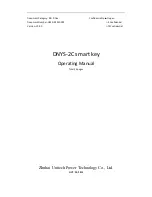
SERVICE LEVEL MAINTENANCE
30
CONVEYOR BELT TRACKING AND CENTERING
ADJUSTMENTS
(See Figure 18)
If tracking or centering problems occur, first check
for unequal tension measurement on the conveyor
belt tension adjusters. Also check for a buildup of top
dressing material under the belt or on the conveyor belt
rollers.
It is very important during the first 10-15 hours of
operation to frequently check the 1530 conveyor belt for
misalignment. All conveyor belts have break-in periods
to train the conveyor belt to track properly. During
break-in, some irregular movement can be expected.
After the break-in period, only normal inspection and
adjustment will be necessary.
The conveyor belt scraper assembly should be
inspected to insure that the scraper blade is applying
uniform pressure across the belt.
Step 1.
Set each conveyor belt tension adjuster screw so
that 19 mm (3/4”) of thread is visible behind the nut.
Operate the machine with the hopper empty. If the
belt is not tracking properly, make quarter (1/4) turn
adjustments to one tensioner until the belt tracks
true. It is very important to give the conveyor belt
enough time (minimum of 10 rotations) to move into
its new position after turning the adjuster screws.
When the conveyor belt starts to run true, continue
running (with empty hopper) for fifteen minutes.
Step 2.
Fully load the 1530 hopper with top dressing
material and operate the conveyor belt. It is normal
for the conveyor belt to slightly move from side to
side when the hopper is loaded. Check tracking and
make small adjustments if needed. Both ends of
the rear roller should be visible when the conveyor
belt is running true. It is very important to give the
conveyor belt enough time (minimum of 10 rotations
per adjustment) to move into its new position before
making any additional adjustments.
Step 3.
After this initial conveyor belt break-in and
training period, use the top dresser as instructed
in the manual. Check the conveyor belt after every
load and make small corrective adjustments as
needed After 10 - 15 hours of use the conveyor
belt should be broken-in and tracking correctly.
Step 4.
After extended use, top dressing material
may build up on the front and rear conveyor belt
rollers causing undue tension on the conveyor
belt or cause tracking problems. Clean the rollers
before adjusting the conveyor belt tension. Before
adjusting the belt, check the following:
● Check for a buildup of top dressing material on the
inside of the conveyor belt.
● Check for a buildup of top dressing material on the
idler and drive conveyor belt rollers.
● Look for damaged, worn or loose bearings on the
idler and drive conveyor belt rollers.
● Look for loose, broken or damaged conveyor belt
tension adjusters.
TOP VIEW
(SHOWN WITH
HOPPER REMOVED)
IF THE CONVEYOR
BELT TRACKS TO
FAR TOWARDS
THIS SIDE -
TIGHTEN THIS
TENSION
ADJUSTER SCREW
OR LOOSEN THE
OPPOSITE SIDE
ADJUSTER
IF THE CONVEYOR
BELT TRACKS TO
FAR TOWARDS
THIS SIDE -
TIGHTEN THIS
TENSION
ADJUSTER SCREW
OR LOOSEN THE
OPPOSITE SIDE
ADJUSTER
FIGURE 18
SV85804-05
















































